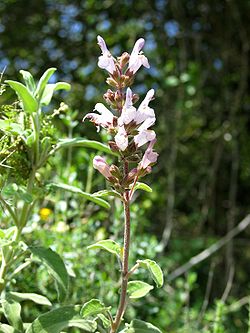Salvia fruticosa
| Habit | shrub
| |
|---|---|---|
| Height: | ⇕ | 36 in"in" can not be assigned to a declared number type with value 36. |
| Width: | ⇔ | 24 in"in" can not be assigned to a declared number type with value 24. |
| Lifespan: | ⌛ | perennial |
| Exposure: | ☼ | sun |
|---|---|---|
| Features: | ✓ | evergreen |
| USDA Zones: | 8 to 10 | |
| Flower features: | ❀ | blue, purple |
|
Salvia > |
Mill. > |
Salvia fruticosa (Greek sage) is a perennial herb or sub-shrub[1] native to the Mediterranean and the Canary Islands.
Greek sage grows 2 ft high and wide, with the flower stalks rising 1 ft or more above the foliage. The entire plant is covered with hairs, with numerous leaves of various sizes growing in clusters, giving it a silvery and bushy appearance. The flowers are pinkish-lavender, about .5 in long, growing in whorls along the inflorescence, and held in a small oxblood-red five-pointed hairy calyx. In its native environment it grows as part of the Maquis shrubland and several other open plant communities, but populations composed entirely of Salvia fruticosa are not uncommon.[2]
It is also grown as an ornamental flowering shrub, preferring full sun, well-draining soil, and good air circulation. Hardy to 20 degrees F., it is very drought resistant. The leaves have a high oil content, with some of the same chemicals as lavender.[2]
Due its wide variation in leaf shape, there has been a great deal of taxonomic confusion over the years, with many of the leaf variations of Salvia fruticosa being named as distinct species.
Greek sage accounts for 50-95% of the dried sage sold in North America.[3]
In its native habitat, it frequently develops woolly galls about 1 inch in diameter which are called 'apples'. These 'apples' are peeled and eaten when they are soft, and are described as being fragrant, juicy, and tasty.[2]
Cultivation
Propagation
Pests and diseases
Varieties
Gallery
References
- ↑ Near the limits of its cold-hardiness, woody stems of Salvia fruticosa may die back almost to the ground.
- ↑ 2.0 2.1 2.2 Cite error: Invalid
<ref>tag; no text was provided for refs namedClebsch - ↑ Hanson, Beth (2004). Designing an Herb Garden. Brooklyn Botanic Garden. pp. 58. ISBN 9781889538631. http://books.google.com/books?id=JLHt5zaEWnoC&pg=PA58.
External links
- w:Salvia fruticosa. Some of the material on this page may be from Wikipedia, under the Creative Commons license.
- Salvia fruticosa QR Code (Size 50, 100, 200, 500)
